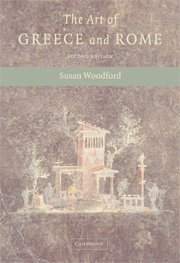Book contents
- Frontmatter
- Contents
- List of Illustrations
- Acknowledgements
- Maps
- Introduction
- PART I THE ARCHAIC AND CLASSICAL PERIODS: PROGRESS AND PROBLEMS
- PART II THE FOURTH CENTURY BC AND THE HELLENISTIC PERIOD: INNOVATION AND RENOVATION
- PART III THE ROMAN WORLD: ADOPTION AND TRANSFORMATION OF THE GREEK LEGACY
- Epilogue
- Appendix: How We Know What We Think We Know
- Glossary
- Further reading
- Index
Epilogue
- Frontmatter
- Contents
- List of Illustrations
- Acknowledgements
- Maps
- Introduction
- PART I THE ARCHAIC AND CLASSICAL PERIODS: PROGRESS AND PROBLEMS
- PART II THE FOURTH CENTURY BC AND THE HELLENISTIC PERIOD: INNOVATION AND RENOVATION
- PART III THE ROMAN WORLD: ADOPTION AND TRANSFORMATION OF THE GREEK LEGACY
- Epilogue
- Appendix: How We Know What We Think We Know
- Glossary
- Further reading
- Index
Summary
Time, war and vandalism have all contributed to the destruction of the art of Greece and Rome. Mere fragments have survived, and yet these have often proved inspiration enough for later ages.
Even as early as the Carolingian period (8th-9th centuries), artists and thinkers began to look back to pagan antiquity for models of humanity and culture in art and literature. But it was only in the Renaissance (beginning in the 15th century) that the art of Rome came to be fully appreciated in its own right. From that time on it has been ceaselessly studied, copied, admired and analysed. During the neo-classical period (the 18th century) people became increasingly aware of the differences between Greek art and Roman art instead of lumping them together as ‘classical antiquity’, and this distinction has been further refined as Greek art has come to be increasingly well understood.
The newly emerging urban societies of the Renaissance were immensely impressed by what they learned of the urban societies of antiquity. For centuries the revival of antiquity seemed the highest possible goal for civilised man. Even plaster casts and humble Latin texts were enthusiastically used to open receptive eyes and minds to the glories of the past.
The 21st century has other concerns. The intensity of passion once felt for the art of Greece and Rome has faded, but the beauty and power of the creations themselves remain, mute but eloquent testimony to the glory that was Greece and the grandeur that was Rome.
- Type
- Chapter
- Information
- The Art of Greece and Rome , pp. 138Publisher: Cambridge University PressPrint publication year: 2004



